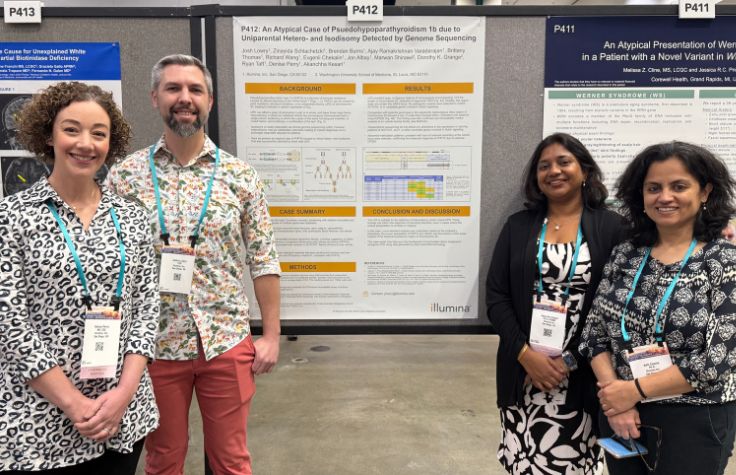
October 23, 2024
This summer, Tim Roloff Handschin, PhD, who coleads the Microbial Genomics Group at the Institute for Medical Microbiology (IMM), received a compact but powerful instrument at his lab on the University of Zurich campus. “The first impression we had of the instrument was that it was rather small,” he says. “We were expecting a bigger machine for what it was supposed to be able to do.”
Roloff and his team were among the first to receive the new VR���˲�Ʊ MiSeq i100 as part of alpha testing before the product was officially announced in October. The MiSeq i100 is VR���˲�Ʊ’s most innovative, accessible, and sustainable benchtop sequencer yet. It’s easy to use and to set up: The team started their first sequencing run within half an hour of installing it.
“What has impressed us the most with this instrument is the short runtime,” Roloff says. Before they received the MiSeq i100, it took his team 19 hours to complete a sequencing run on their NextSeq 1000. Now they can do the same thing in seven hours—and start two runs in a single day. “This will really be a game changer in the field of medical microbiology, because you can easily run a sequencing run in one day and then report the results within 24 hours.”
Roloff’s lab, one of 10 at IMM, performs whole-genome sequencing on bacteria and fungi. Their research focuses mainly on the mechanisms that lead to antimicrobial resistance, and ways to develop new diagnostic tests and antimicrobial drugs. They’re also a diagnostic lab serving clinics in the Zurich metropolitan area and across Switzerland.
Roloff explains that, while bacterial genomes are small and don’t require a lot of sequencing data, speed in microbiology research is still key because the ultimate goal is to provide information that prevents the spread of pathogens or leads to the correct treatment.
“The reduced run times will really speed up the process and make whole-genome sequencing much more relevant for microbial questions and diagnostics,” he says. “And given the up to 100 million reads you will be able to get from the new machine, you can do a lot of experiments in parallel, a lot of bacterial genomes in parallel.”
The MiSeq i100 makes index-first sequencing possible, which means users will have information early in the run about which samples have sufficient indexed representation, as well as how much data each sample will produce. In about two hours, Roloff’s team can begin analyzing the sequenced indices while the rest of the fragments are still being processed. “This gives you totally new possibilities to design library prep methods that take advantage of that,” Roloff says. In addition to library preparation, they can research new diagnostic tests, which “will be very interesting in our setting.” He imagines developing tests that combine screening for certain bacteria with WGS. After two hours, they would be able to tell if the bacteria of interest is present. After seven hours, they could filter the full data set from the run to analyze the specific genome associated with that bacteria to determine the presence of antibiotic resistance genes, virulence factors, and more.

“The impact that the new instrument will have on microbial diagnostic workflows using next-generation sequencing will be massive,” he says.
Roloff and his team were excited to hear that the MiSeq i100 reagents can be shipped at room temperature and can be stored that way, because that meant there would be less waste and they would not need any freezers or refrigerators. This would save money on storage. “It actually makes each sequencing run cheaper.”
Roloff says they hadn’t realized the additional flexibility that room-temperature storage would give them. Being able to bypass thawing time meant they could begin a run at a moment’s notice.
“Turnaround time is really what has been the problem in the past,” he says. “We’ve seen in the COVID crisis that NGS results were always lagging behind and you could only retrospectively analyze, for instance, which lineage was there.” The workflow in Roloff’s lab took approximately a week to report whole-genome sequencing data. “PCR was just much faster.”
A significantly reduced turnaround time essentially removes the reliance on PCR or other methods, which look at only a single factor and don’t provide as much information.
One final advantage the team found in the MiSeq i100, which comes with DRAGEN software on board: The data quality was as good as or better than they expected, and they could immediately get the output on the screen. “You don’t need any bioinformatician waiting for the data and analyzing what you have produced,” Roloff says. “Even the technician can directly report the results of a sequencing run.
“With this new instrument, VR���˲�Ʊ makes benchtop sequencing much more valuable for medical microbiology, because it’s much faster to analyze bacteria, it’s cheaper and easier to store your reagents, and the ease of use actually reduces the amount of personnel you need around sequencing—the service technicians, bioinformaticians, and so on. We were very excited to join this test of the new instrument, but we were actually positively surprised by all the possibilities we suddenly had.” ◆


